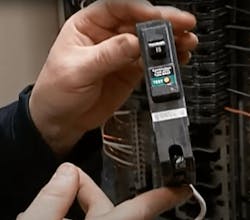Low-Cost Fire Protection For New Home Building/Remodeling
Each year 25,000 electrical fires occur in the U.S. killing hundreds, injuring thousands and resulting in more than $1 billion in property damage, according to the U.S. Fire Administration (USFA).
Home builders, electrical manufacturers and fire safety experts are on the front line in implementing solutions that can avoid costly damage and prevent injuries and deaths. Arc fault circuit interrupters (AFCI) are a low-cost solution that have been a National Electrical Code (NEC) requirement for more than 20 years. NEC requirement adoption can vary by state and municipality, but it is important to follow full NEC guidelines to minimize the risk of electrical fires.
How does this fire protection work?
“AFCIs detect and de-energize dangerous arc faults that standard circuit breakers cannot. An arcing fault creates sparks which often lead to electrical fires,” explains Ashley Bryant, senior product manager at a major electrical manufacturer.
“This can occur when a nail damages wiring behind a wall; it may be a loose connection; inadequate wire insulation; damaged power cords; overloaded outlets; or even damaged appliances,” said Keith Waters, industry standards manager at a major electrical manufacturer.
Why are fire prevention devices important?
“These devices help prevent injuries and deaths and have potential to virtually eliminate damage to homes,” said Kevin Arnold, P.E. Manager National Codes & Standards and Industry Relations at a major electrical manufacturer and a licensed master electrician. “Knowing you are living in a home that has the ability to prevent an electrical fire before it starts increases safety and affords peace of mind to consumers.”
The Consumer Product Safety Commission (CPSC) estimates nearly 50 percent of all home electrical fires annually could be prevented with AFCIs. AFCIs became an NEC requirement in 1999 and combined with other fire prevention technologies and building materials, they have helped significantly decrease electrical residential fires, according to the USFA.
How much does this protection cost?
“Considering AFCI benefits, the actual cost is minimal. Some insurance companies even provide discounts to homeowners that have increased fire safety technology in their homes,” said Bryant. Waters added, “The price of an AFCI unit is around $40, according to major U.S. home improvement retailers. A dual function AFCI/GFCI breaker adds only $7 to the price.”
Based on averages, a 2,100 square foot home may require six AFCI units, which means the added cost to construction would be between $240 and $282 per home to protect a home from electrical arcing.
What more can we do to prevent fires?
“All of the building industries need to work together to make sure homebuyers are educated on what it takes to protect their property and their families from electrical fires at home,” said Waters.
“Licensed electricians/installers are responsible for knowing NEC requirements and can work closely with builders and homeowners to help create the safest homes possible by offering input on circuit breaker devices and other construction materials.” said Arnold.
“With a concerted effort, arc fault-induced fires, deaths, and injuries could be virtually eliminated. The need is clear, and the technology has proven itself, but it is important for all states to adopt the NEC requirements to help make arcing fault fires a thing of the past,” added Bryant.
